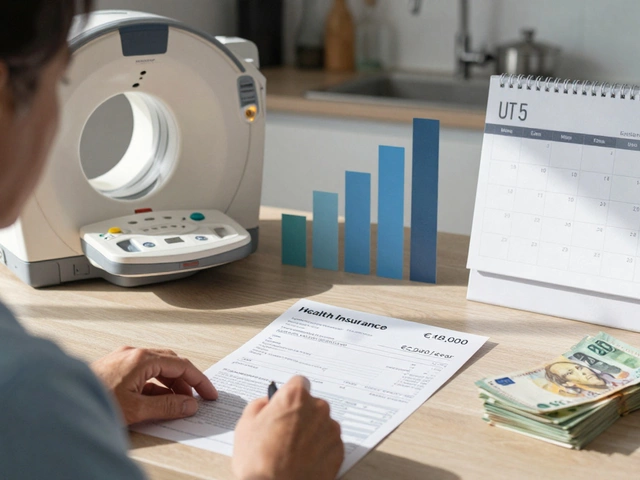Most folks think of pain management as popping pills, slapping on a heat pack, or booking another appointment. But there’s this sneaky method almost nobody talks about—even though it’s proven, safe, and fits into daily life: pacing.
Pacing is about balancing activity and rest so your body doesn’t end up in that burnout-flare-repeat cycle. It’s not about doing less forever, but about planning each day so you get the most done while keeping pain at bay. And no, you don’t need a therapist to show you how—although your doctor may never mention it.
Think about the last time you felt OK and took it as a green light to power through chores, only to crash the next day. That’s where pacing steps in. With some tweaks and a bit of attention to how your body feels, you can break this cycle. Ready to learn how small shifts in how you move, rest, and plan can make a massive difference? Let’s get practical.
- Why People Ignore Pacing
- What Is Pacing—And Why Does It Matter?
- How to Start Pacing Without Overcomplicating Things
- Common Pitfalls: What People Get Wrong About Pacing
- Simple Tools & Tips to Track Your Progress
- Real Stories: How Pacing Helped Others
Why People Ignore Pacing
Here’s the deal: most people living with chronic pain don’t even know what pacing is, or they brush it off as too simple to work. Doctors and pain clinics still tend to put meds, injections, or even surgery first on the list for pain management. Pacing rarely gets a headline—even in big-name pain guidelines from 2024, exercise and medication hog the spotlight.
Another reason pacing slides under the radar? It’s not flashy. People want a fix, not another skill to practice. Medications promise quick relief, while pacing takes patience and a bit of trial and error. After all, who’s got the energy to learn a new routine when just getting dressed hurts?
There’s also this myth that pacing means giving up activities you love. A lot of people with chronic pain grew up hearing “push through the pain” or “don’t let it beat you.” So, throttling back feels like losing. In reality, pacing is about doing the things you care about—just smarter, with less fallout the next day.
It doesn’t help that most friends or family don’t get it. When you cancel plans or take breaks, folks might think you’re being dramatic or lazy. That outside pressure makes pacing feel like the odd one out compared to mainstream pain relief methods.
One 2023 study from the International Journal of Behavioral Medicine found that less than 1 in 5 people with fibromyalgia had ever tried structured pacing, even though over 80% had heard about it in support groups or online. People said it seemed ‘too slow’ or ‘not real treatment.’
Honestly, a lot of the blame goes to how pacing is explained. Online articles sometimes turn it into a giant self-improvement project with way too many rules. No one wants to fill out 12-page diaries or follow strict schedules. That’s why most folks ignore it—and miss out on its real benefits.
What Is Pacing—And Why Does It Matter?
If you’ve never heard of pacing in pain management, don’t worry—you’re not alone. But it’s a game changer for people with chronic pain. Pacing is basically about spreading out your activity and your rest throughout the day. That might sound simple, but it’s not just about taking more breaks. It’s about working with your energy and pain levels—so you don’t accidentally overdo it and pay for it later.
Here’s the deal: With conditions like fibromyalgia, arthritis, or ongoing back pain, pushing through pain can turn a good day into a bad week. Experts found that most people with ongoing pain fall into a “boom and bust” cycle—using energy all at once and then being forced to crash. Pacing aims to break that pattern.
The cool part? Research from the British Pain Society shows pacing helps people manage daily life better and gives them more control. Instead of just reacting to pain flares after the fact, you use pacing as a smart plan ahead of time.
- Pacing is personal—you set your own limits based on how you feel, not on what others think you should do.
- It’s about finding the “sweet spot” between doing too much and doing too little.
- It can be as simple as taking a pause before pain spikes, switching tasks, or just standing up and stretching every 20 minutes.
Let’s make this really concrete with a comparison:
| Strategy | What Usually Happens |
|---|---|
| No pacing (push through everything) | Pain flares up, you crash, need days to recover |
| Pacing (plan breaks) | Energy and symptoms stay steady, you get more done over time |
If you’re tired of the up-and-down cycle, give this method a shot. It isn’t about giving up on what you want to do, but about giving yourself the best shot at enjoying it—all while keeping pain relief realistic and manageable.
How to Start Pacing Without Overcomplicating Things
When it comes to pain management, pacing sounds almost too simple. But the trick is to avoid turning it into another stressful to-do list. Start with the basics before adding anything fancy.
First, pay attention to your daily routines and notice where your pain starts spiking. Are you pushing through two hours of cleaning? Is it working at your desk without breaks? Jot these times down for a day or two—nothing formal, just rough notes on your phone or scraps of paper. That’s your personal "danger zone" map.
Next, pick one task that usually triggers a flare-up. Let’s say it’s vacuuming. Instead of doing every room in one go, break it up. Do a single room, then sit or walk around for five minutes before you hit the next one. Set a phone timer if you tend to lose track. Most people do.
- Set activity limits: Use your pain as a signal, not a challenge to push through. When pain ramps up, it’s time to pause—not quit, just shift gears.
- Mix rest with action: Break longer tasks into smaller batches. Stand up and stretch after sitting for 30 minutes. Chop meal prep into chunks throughout the day.
- Plan recovery time: Schedule in breaks before you feel wiped out. For example, if grocery shopping floors you, plan a coffee break in the middle—even if that means sitting in your car for ten minutes.
- Monitor energy, not just pain: If your body feels heavy or you’re suddenly grumpy, that’s your cue to rest. Fatigue often predicts pain flares by an hour or two.
This isn’t just theory. Studies in arthritis and chronic pain clinics found pacing cut flare-ups by more than 30% over six months. Most people found it way easier to stick to than strict exercise plans or diet changes.
| Pacing Habit | Result (After 6 Months) |
|---|---|
| Planned breaks every hour | 30% fewer flare-ups |
| Splitting chores into shorter blocks | 40% fewer pain spikes |
The only way to mess up pacing is to ignore your limits or expect perfection. Progress beats perfection every time. Start with one area of your routine and try it for a week. You’ll notice your chronic pain isn’t running the show anymore—you are.

Common Pitfalls: What People Get Wrong About Pacing
Plenty of people hear about pacing for chronic pain and think they’re already doing it. But even folks on pain forums admit: it’s easy to get tripped up. Here’s where things usually go sideways.
- Boom and Bust: This is the classic trap—feeling better one day and pushing way too hard, then spending the next two days wiped out. True pacing means you don’t empty your tank on the good days, no matter how tempting it is to catch up on everything.
- Thinking Rest Is Always the Answer: Too much rest can actually make pain feel worse. The trick with pacing isn’t just stopping when you’re tired; it’s about mixing movement with downtime and not waiting until you’re already hurting to take a break.
- Skipping Planning: Winging it rarely works. You have to set limits before you start an activity, not when you’re halfway through. Schedules and timers can keep you honest.
- Ignoring Progress: A lot of people don’t write down what works or what triggers flares. Without tracking, it’s easy to get stuck—or worse, to miss the fact that you’re actually improving.
Check out this quick table showing some common pacing mistakes and their impact:
| Pacing Mistake | What Usually Happens |
|---|---|
| Pushing through pain | Increased pain and longer recovery |
| Too much rest | Stiffness, muscle loss, mood dips |
| No plan or limits | Pain spikes, frustration, guilt |
| Not tracking activities | No idea what's working or making things worse |
One underrated fact—most people assume pacing is the same for everyone. Actually, your sweet spot for rest and activity is as unique as your pain story. What helps your neighbor, or even someone in an online group, might not be the answer for you.
If you recognize yourself in any of these mistakes, don’t stress. It takes practice. Even folks who write books on pain management admit to slipping up now and again. Just notice, adjust your plan, and keep moving.
Simple Tools & Tips to Track Your Progress
When it comes to pain management with pacing, tracking your progress doesn’t have to be fancy—or expensive. In fact, the simplest tools usually work best. The goal is to see patterns over time, spot what triggers pain spikes, and learn what days go smoother so you can repeat what works.
Here’s how you can make tracking part of your routine:
- Pain Diaries: A basic notebook is powerful. Just jot down what you did, how you felt before and after, and your pain level (use a 0-10 scale). Over time, you’ll spot things like “Laundry always leaves me wiped out for a day” or “Short walks keep my pain level steady.”
- Apps: Tons of free apps help with tracking chronic pain and activities. Curable, My Pain Diary, and Manage My Pain let you log symptoms, activity, rest, and medication. They also turn entries into graphs so you can show your doctor real data instead of guesswork.
- Activity Timers: If you tend to overdo it, set an alarm on your phone or smartwatch for activity-rest intervals—try 20 minutes on, 5 minutes off. This helps you stick to your plan and reduces the risk of flare-ups.
- Pacing Charts: Make a weekly chart on paper or a spreadsheet. List energy-draining activities (like cleaning, shopping, cooking) and rate how you felt after each. Rate pain severity, energy, and mood—over a few weeks, you start to see exactly which routines need tweaking.
One small study in 2023 found that people who regularly tracked daily activities and pain scores reported a 22% drop in severe pain episodes after two months. They also said their energy lasted longer through the day.
| Tool | What It Tracks | Best For |
|---|---|---|
| Pain Diary/Notebook | Daily pain, activities, mood | Visual learners |
| Apps | Detailed logging, graphs, medication | Tech-savvy folks |
| Timers | Activity breaks, reminders | People who overdo it |
| Pacing Chart | Energy, flare patterns | Routine planners |
Don’t forget, progress isn’t always a straight line. What matters is seeing the big picture—maybe you have one less tough day this week than last. Share your notes at your next appointment so your healthcare team sees what’s actually happening. Making tracking a habit can totally change your chronic pain journey—sometimes more than any prescription.
Real Stories: How Pacing Helped Others
Sometimes the best way to understand pacing for pain management is to hear how it changes real lives. So, let’s look at what actually happens when people ditch the push-crash cycle and start working with their body instead of against it.
Jenny, who lives with fibromyalgia, was stuck spending half her week knocked out on the couch after trying to clean her house in one go. Her physical therapist suggested she break that chore into short, spaced-out sessions—just 10-15 minutes at a time, followed by a quick rest. After a few weeks, not only did her pain levels even out, but she quit missing her kids' soccer games because she wasn’t totally wiped out for days. When she started writing down her activity bursts and rating her pain, she saw clear patterns on her good and bad days. This made planning way less stressful.
Now, take Mike. He’s a 52-year-old with chronic lower back pain from an old construction injury. Mike always powered through yard work—even if it meant paying for it all weekend. Once his doctor introduced him to pacing, he set timers for basic yard chores: mow for 20 minutes, rest 10 minutes, repeat as needed. He used a simple notebook to track what worked. Within a month, flare-ups dropped from three a week to just one. That notebook turned out to be his secret weapon.
Want some quick numbers? A 2023 UK survey of arthritis patients found that folks who used structured pacing had 25% fewer days with high pain compared to those who didn’t pace. It’s not about stopping everything you enjoy—it’s about spreading energy and effort so you can keep doing the things you love without the crash.
| Benefit | Percentage Reporting |
|---|---|
| Reduced Pain Flare-Ups | 67% |
| More Consistent Energy | 59% |
| Increased Daily Activity | 41% |
Everyone’s journey looks a little different, but these stories prove one thing: with a little bit of planning and honest tracking, pacing can move the needle where meds and gadgets sometimes don’t. It’s not magic, but it sure feels close—especially when that means getting through grocery shopping or a family day out without a pain spiral.




